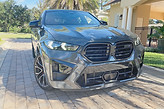
Our Headlong Rush to Electric Vehicles
by Brian Douglas
A quick glance at this article’s title might suggest to readers that the author doesn’t like electric vehicles. Allow me to set the record straight. I enjoy driving the new quick, quiet vehicles that do not emit products of combustion from fossil fuels. So what’s wrong with the state and federal governments quickly regulating us into EVs? I’ll let you decide whether this extreme timing makes sense after sharing a few facts.
A Short EV History
Electric vehicles seem relatively new to the automotive landscape, but they have been around since 1881 when Gustave Trouvé drove his rather odd battery-powered tricycle around Parisian streets. That led to batteries and an electric motor propelling those carriages around that had been pulled by horses. At the same time, other mechanically-skilled inventors were installing combustion engines and fuel tanks into similar carriages to put horses out of work.
The contest was short lived. Smoky, noisy gas engines won the vehicle propulsion battle over the EVs. Why? Some suggest that nefarious petroleum magnates like John D. Rockefeller may have put an oily thumb on the scale. He didn’t have to because energy density simply won hands down. The battery electrics just didn’t go very far before requiring a long recharge and we Yanks like to get around with as little fuss as possible.
It’s fair to assume that we’ve made some progress since the French guy was tinkering with electrical propulsion 142-years ago. And of course we have. We’ve dramatically improved storage batteries and electric motors. We’ve also developed state of art control systems with on-board computers and software to maximize efficiency for added range. But we can’t easily solve the physics of energy density.
Here’s an example of energy density between petroleum and stored electricity in very similar new vehicles. Hyundai’s Kona SUV has a range of 422-miles with 12.4-gallons of gasoline. It takes about five-minutes to refill the tank and the gas weighs about 74-pounds. The Kona Electric’s range is 258-miles from electricity stored in battery that weighs about 700-pounds. It takes about 9.5 hours to refill that battery with a 240-volt home charger or from most of the non-Tesla public chargers. The Kona, like most new EVs, can utilize a public “fast charger” that could reduce the refill time to about an hour if one is available and in working order. And while charging at home might save some money versus gasoline, buying electric refills on road trips often cost more per mile. And the Kona Electric retails for nearly $10,000 more than its gas sibling.

Gustave Trouvé 1881

Carl Benz 1885




The Electric Vehicle Lifestyle
It’s relatively easy for elected officials and bureaucrats to make rules and regulations that have unintended consequences, especially when those same rule-makers don’t have to suffer the outcome. Those who are not driven to their office in a large, chauffeured SUV might actually own an EV. And if they’re like those of us who own a single-family home with an EV charger in the garage, electric transportation works well. In my upscale Silicon Valley neighborhood, half the population owned a Tesla. And every one of them also owned a petrol vehicle to take trips without worry or when the power grid was turned off.
For the sizable portion of the population who rent or who live in high-density housing, EV ownership is more challenging. Electric evangelists quickly assert that fast chargers will suffice, but that assumes accessibility and often the higher cost of the recharge. And the constant fast charge problem few talk about is the diminishing of battery capacity, a problem that’s hugely expensive to fix. About $100 will buy the 12-volt battery for most cars. The cost of an EV battery replacement ranges from $5,000 to $20,000 depending on its size.
A Reasonable Path
According to The Department of Transportation, most of us drive about 37-miles a day. So if you’re not a travelling salesman or have a hideous commute, you can wrap an EV and petrol car into one package with a plug-in hybrid model. I recently tested Mitsubishi’s Outlander PHEV, a seven-passenger SUV that travels 38-miles on electricity before starting the gas engine. Over the week’s use, I took a couple of short trips just to test both power sources. The result was a 91 MPG average for the week, pretty good for this big fella, and there are other plug-in hybrids that do just as well. Progress like this will get us to vehicle carbon reduction if we let market demand and common sense go to work.







